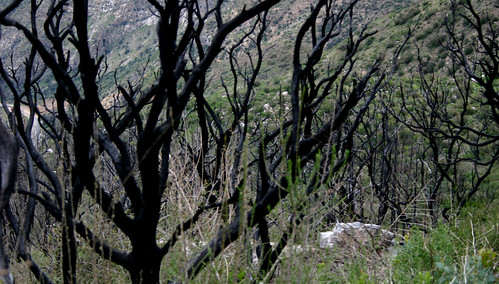People's Pets, Pests and Parasites...
Mountains that ring Los Angeles burn so frequently that the trees do not have time to re-grow. Fire ecology means that the plants and animals have adapted to periodic conflagrations. However, even though the mountains are not developed, the cities and the ever-increasing human environment affect them, and so fire comes more frequently and has more devastating effects. (http://www.werc.usgs.gov/news/1999-09-16b.html ) What this means is that this undeveloped land is in effect, 'developed' and the plants and animals that live there are more inclined to be tolerant of disturbance and dependant on humans.
What kinds of plants and animals live with or near people and benefit from their proximity?
Mostly animals domesticated or habituated to take food and find protection from living near or with humans... and they bring all of their pests and parasites, too.
Zoonosis disease is like a bonus point for civilization and animal husbandry. Zoonosis is when viral and bacterial disease and all other parasitic diseases, which are not species specific but can jump easily from one animal to another. Pets, dependent on people for food shelter and reproduction... have transmitted Tuberculosis, Plague, Rabies, Ringworm, and Lyme disease. Domesticated food animals like pigs, live in crowded conditions near farmers and cities. Diseases like influenza viral strains, of say, the avian plus the human specific influenza viruses, (which have receptors and similar biochemistry within pigs) which can either kill one or the other, now, within the vessel of the pigs' systems, can do both. Even pet dogs can be infected and can carry potential diseases that may be passed onto their owners and trainers, which may have originated from some other animals across the globe. (http://www.recombinomics.com/News/05140503/H3N8_Florida_Widespread.html)
The pests of humanity like rats and mosquitoes have other interesting stories. Rats and mice that carry the Hantavirus come in contact with humans because of seasonal conditions. (http://coloherp.org/cb-news/archive/vet-med/hantavir.php) When rains increase the food supply for rodents in the Southwest, their populations expand, but drought brings them into cities where people sprinkle and store food. The rodents invade the peoples' homes and transfer the virus through their excrement either fresh or dry. Although, experts have said that Hantavirus is rare it has found a home in large cities like New York. (http://www.health.state.ny.us/nysdoh/communicable_diseases/en/hanta.htm)
People spray, scrape, dig, uproot, and pour concrete over the land. Near the confines of their cities, plant and animal life is different. Plants and animals must quickly take advantage of momentary peaks of water use or rain, crops or garbage, pets of prey or illness. What plants or animals existed where the people live, are gone or mostly and those at the perimeter of the cities are mostly gone, too.
Weeds - plants that take advantage of the disturbance caused by people - grow quickly, fruit and die. The insects at the interface of the human environment are mostly the groups that either eat what humans grow or throw out, or eat the detritus and carrion.
So, in the spring of 2005, affected by several years of drought and fire, the rains came. Forests protect the mountainside and the lower watersheds by holding back waters and rocks and mud. The forests of Los Angeles were mostly gone, burned, or so near completely burned, they looked like a landscape of black skeletons.
The Cement Rivers carried the majority of the water to the ocean. The Bolsa Chica may not survive another season of rain like this, especially if fires come in summer and burn what is left of the San Gabriel's.
Sunday, May 15, 2005
black trees
Subscribe to:
Post Comments (Atom)

No comments:
Post a Comment